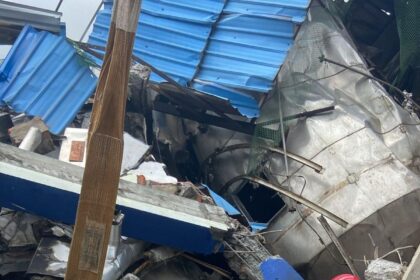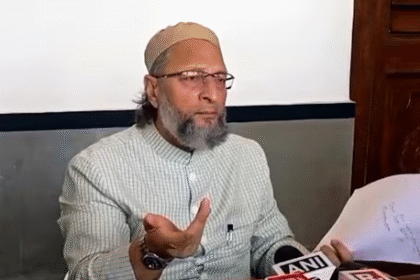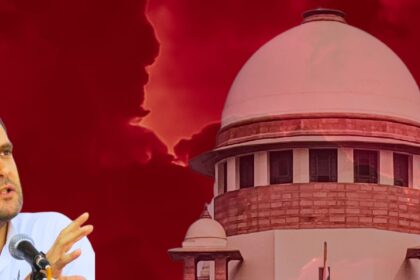Vikhroli Bridge Snarls: 3 Major Bottlenecks Frustrate 10,000+ Daily Commuters
Commuters complain about extremely slow-moving traffic on the bridge, winding traffic jams on approach roads and chaos at the eastern end of the bridge
Mumbai: Traffic on the three-lane, 615-metre Vikhroli bridge, which connects the LBS Marg with the Eastern Express Highway (EEH), has surged since it was opened around two weeks ago. But commuters are already complaining about a fresh set of problems including extremely slow-moving traffic on the bridge, winding traffic jams on approach roads and chaos at the eastern end of the bridge, located close to a junction that connects various neighbourhoods in Vikhroli with the EEH and the railway station. Concerns are also rife over the design of the bridge, which has several speedbreakers and no median to separate vehicles headed in opposite directions.
Traffic snarls are common at the western-end of the bridge which links up with LBS Marg, as vehicles wait for the signal to turn green to disembark from the bridge onto the road. During peak hours, motorists have to wait for 20-30 minutes, with traffic spilling over onto the adjacent lane, meant for vehicles headed in the opposite direction.
The eastern-end of the bridge that links up with the EEH presents a far greater problem as it is located close to a junction with too many intersecting roads and without a traffic signal.
“One road caters to vehicles coming into Vikhroli from the EEH, another leads to Tagore Nagar located beside the bridge, while yet another road leads to Kannamwar Nagar on the opposite side of the EEH,” said an official from the BMC’s bridges department. “Besides, vehicles headed to Vikhroli station also pass through the junction. It is too chaotic.”
Traffic movement on the bridge is extremely slow due to the presence of at least five speedbreakers, absence of a road median and the large volume of traffic, said commuters.
Roads of Mumbai, a handle on social media platform X who wishes to stay anonymous, said it took him over 20 minutes to get to the bridge from the EEH ramp – a distance of barely 300 metres – and another 11 minutes to traverse the 615-metre bridge.

“But more than the duration, I was struck by the poor safety on the bridge,” he told Hindustan Times. “Why would anyone come up with a three-lane bridge which is bi-directional? Entry is through a single lane, which becomes a double-lane after a short distance. Move a little ahead, and autorickshaws can be seen overtaking other vehicles using the third lane, which is meant for traffic headed in the opposite direction.”
The road surface was not bad, but the average speed on the bridge didn’t exceed 5 km/hr, he said.
Abhijeet Bangar, additional municipal commissioner (roads and bridges), said the median-less, three-lane design was chosen as two lanes could be dedicated for vehicles headed in one direction depending on traffic flow.
Commuters’ woes aside, the bridge has angered residents of Vikhroli immensely.
“We had warned the BMC and the traffic police several times before the bridge was opened that it would create bottlenecks in the east,” said Sanjay Yelve, a resident of Kannamwar Nagar and president of the Vikhrolikar Vikas Manch.
The bridge’s approach road at the eastern end terminates on a road that leads to Kannamwar Nagar and several other neighbourhoods.
“Because of the bridge, we now have to deal with huge amounts of traffic whenever we travel,” said Yelve. “Besides, we are no longer allowed to take a U-turn to get to the station and have to take a long detour, which adds to our travel time.”
Aware of the brewing anger among local residents and commuters, the BMC and traffic police are trying to address the situation. During the peak hours in the morning and evening, five traffic police personnel are deployed at the junction close to the eastern-end of the bridge.
“We will be stationed here to regulate traffic till the situation is sorted as the vehicle flow on the bridge needs to be controlled in accordance with the load,” one of the traffic police personnel on duty told HT.
Bangar said the approach road at the eastern end leading to the bridge was narrow as beautification work was carried out on a wall at the junction earlier.
“We are in the process of acquiring the land at the spot and will widen the road. We are also thinking of constructing a roundabout and figuring out ways to reduce traffic load,” he said.
Anil Kumbhare, joint commissioner of police (traffic) said that the beautification wall was located bang in the middle of the alignment for road widening.
“We have asked for the beautification wall to be shifted. Once that is done and the road is widened, signals will be placed and traffic flow will ease,” he said.
he Vikhroli Road Overbridge (ROB), a cross‑rail connector linking Lal Bahadur Shastri Marg (LBS Road) in Vikhroli West to the Eastern Express Highway (EEH), first entered planning circles in the late 1990s—nearly 25 years ago. Sanctioned around 1997 by Central Railway, subsequent approval under the Mumbai Urban Transport Project (MUTP), and a work order in April 2018 set the stage. But persistent holdups from land acquisition, encroachments, utility shifts, and dating back even decades, dragged completion through cost escalations—from ₹5.7 crore to over ₹105 crore .
Finally, on June 14, 2025, the ROB was opened to traffic at 4 PM—but sans fanfare. Political leaders raced to claim credit; local MLA Sunil Raut marked the opening with a coconut ritual, while party flags and banners dotted the bridge
Constructed at a cost of around ₹105 crore, it spans 615 metres and connects crucial eastern and western corridors . BMC officials estimated it will cut 30 minutes from a typical east-west commute
Speed breakers—2 units, each 3.5 m long—were installed at the LBS Marg entry to reduce speed on the descent. Civic engineers say this was essential: “LBS Marg sees a lot of traffic and the ROB has S‑shaped entrances, so these speed breakers exist to prevent commuters from speeding But commuters counter that the bumps, placed on both ascent and descent, are creating bottlenecks—especially for two-
Even before opening, commuter groups predicted the bridge might create gridlock, not relief. Mid-day warned of expected snarls at the Vikhroli station road junction and Tagore Nagar, as traffic funnels into narrow local roads Local activist Ganesh Shetty, involved since 2002, echoed this: without widening internal roads in Tagore and Kannamwar Nagar, “Vikhroli will be a traffic crisis waiting to happen” .

Local road bottlenecks: Internal roads (e.g., Tagore Nagar, Kannamwar Nagar, LBS Marg, and Vikhroli West) remain narrow, with no right-of-way expansion
Pedestrian exclusion: Despite a foot-over-bridge to cross tracks, no pedestrian provision on the new ROB forces walkers onto old, often unsafe footpaths
BMC officials note the bridge comprises “load test and stability certifications,” with signals, cat eyes, and speed‑breakers in place The Mumbai Traffic Police will dynamically allocate lane directions based on flow But without complementary improvements, these features seem more reactive than holistic.
No ribbon, no ceremony—but political theater ran full throttle. Sunil Raut (UBT Shiv Sena MLA) smeared his face on banners, citing involvement since 2010 Haroon Khan, aligned with Deputy CM Shinde, pointed to past protests halting trains—“traction that led to bridge construction.” Former BJP MP Manoj Kotak claimed persistent behind-the-scenes work coordinating with BMC and railways, especially during COVID setbacks Flags of Shiv Sena, BJP, and allied parties fluttered triumphantly from bridge railings—underscoring the region’s faction-driven political landscape.
Vikhroli ROB is one piece in Mumbai’s ongoing puzzle of east–west connectivity. BMC pledged earlier this year to complete key overbridges in Vikhroli, Carnac, and Gokhale junctions before monsoon storms Another connector, Carnac Bridge, was planned to open shortly after
Past infrastructure examples like the Santacruz–Chembur Link Road (SCLR)—opened in 2014—shaved off 75–90 minutes of travel time, easing congestion in adjacent hubs But other projects like the Jogeshwari–Vikhroli Link Road (JVLR) and sea-links have been plagued by delays and bottlenecks at transitions
Read Also : Left-Wing Democrat Beats Ex-Governor in NY Mayor Primary by 15 Points








